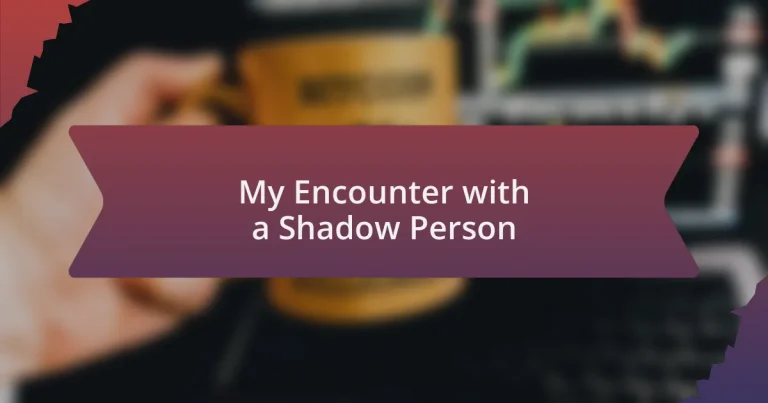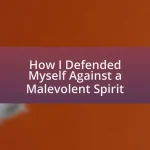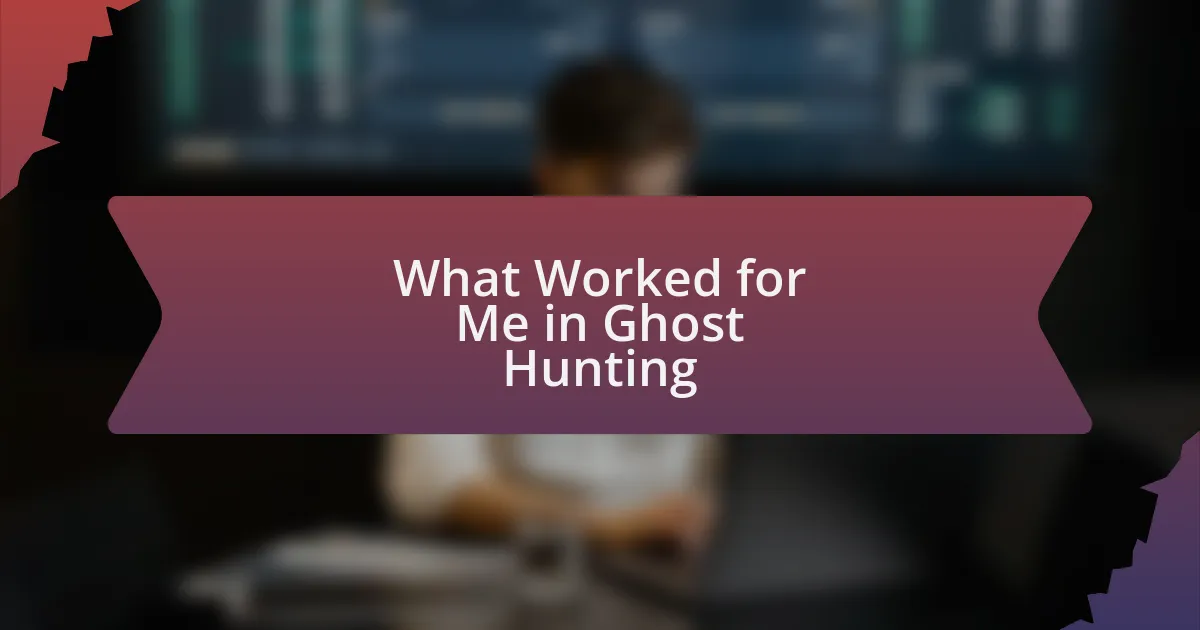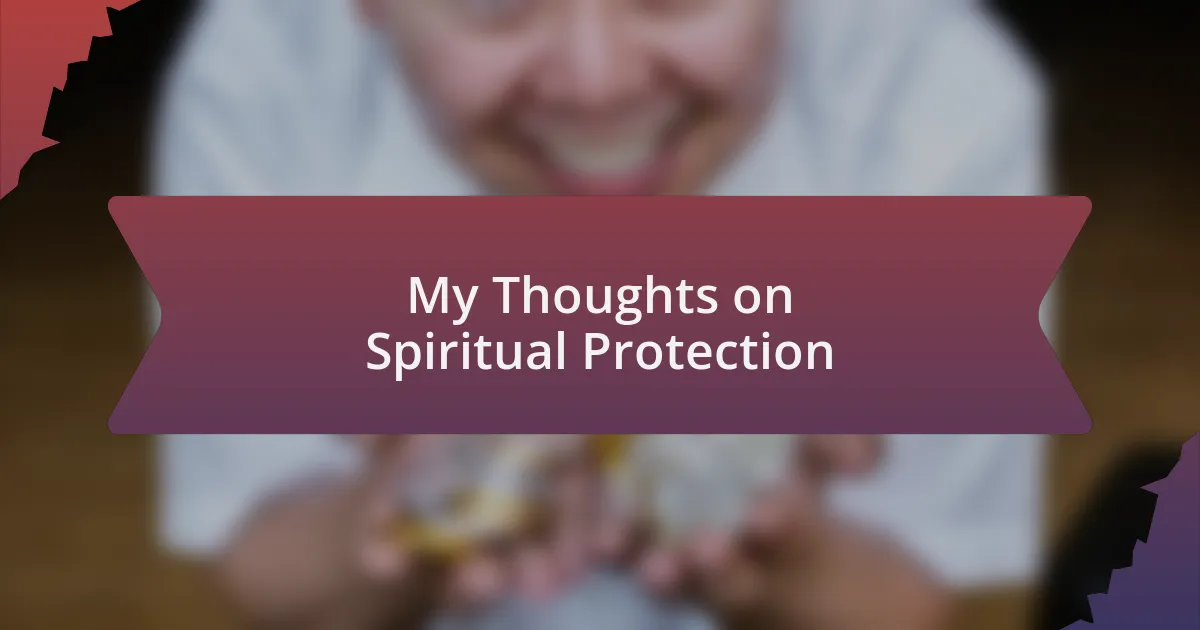Key takeaways:
- Shadow people are described as dark, humanoid figures that evoke strong emotions and may reflect our internal fears and struggles.
- Encounters with shadow people can leave individuals feeling watched or scrutinized, leading to profound emotional experiences.
- Different interpretations exist regarding shadow people, ranging from manifestations of subconscious fears to interdimensional beings observing us.
- Engaging with the fear tied to shadow encounters can transform into curiosity and a desire to explore the unknown.
Author: Evelyn Hartman
Bio: Evelyn Hartman is a contemporary author known for her evocative storytelling and rich character development. With a background in psychology, she weaves intricate narratives that explore the complexities of human relationships and personal growth. Her debut novel, “Whispers in the Wind,” garnered critical acclaim and established her as a powerful voice in modern literature. Evelyn resides in the Pacific Northwest, where she draws inspiration from the vibrant landscapes and diverse communities around her. When she’s not writing, she enjoys hiking, gardening, and spending time with her two rescue dogs.
Understanding Shadow People
Shadow people are often described as dark, humanoid figures that appear in peripheral vision, but what lies beneath this unsettling phenomenon? I remember the first time I caught a glimpse of one; it sent a chill down my spine, leaving me questioning if my mind was simply playing tricks on me or if something far more mysterious lurked nearby. What if these shadows are not just figments of our imagination, but rather entities that exist in a realm we barely understand?
There’s a fascinating discussion surrounding the potential origins of these figures. Some suggest they are spiritual beings, while others hypothesize that they stem from our subconscious fears. I often wonder if they tap into our emotional states, appearing when we are most vulnerable, as if sensing our struggles. Have you ever felt that eerie presence when you were alone, as if someone—or something—was watching you?
The reactions to shadow people can range from fear to curiosity. Many people feel an instinctive dread when encountering these figures, as if they are being warned of unseen dangers. I’ll admit that my initial response was one of terror, but over time, I have grown more intrigued by the idea that these shadows might offer insights into our own experiences, bridging the gap between our reality and a realm beyond our sight. Could they serve as mirrors reflecting our hidden fears and unresolved issues?
Defining Shadow People Encounters
Shadow people encounters are often characterized by the eerie sensation of seeing a darker-than-dark figure dart just out of sight. I recall an instance where I was watching TV late at night when I felt an unsettling movement in the corner of my eye. At first, I dismissed it, but the feeling of being watched lingered, a reminder that some encounters are fleeting yet profoundly impactful.
Many describe these shadow figures as looming presences that seem to drain energy or evoke an intense feeling of dread. During one particularly stressful period in my life, I experienced a shadow figure hovering near my bedside. It felt as though it was feeding off my anxiety, amplifying the tension in the room. What was it trying to convey? Was this entity merely a reflection of my own internal struggles, or was there a deeper connection at play?
The ambiguity of shadow people encounters often leaves individuals questioning their reality. I sometimes find myself reflecting on why these encounters provoke such varied responses; some are paralyzed by fear while others feel an undeniable urge to understand. It’s curious to think: are these shadows merely ghosts of our own fears, or do they symbolize something more significant, something waiting to be explored?
Common Characteristics of Shadow People
The most striking characteristic of shadow people is their fleeting nature, often appearing in peripheral vision only to vanish when directly confronted. I remember a night when I caught a glimpse of a tall, dark figure moving swiftly across my living room, almost as if it were not entirely of this world. It left me with a chilling thought: was this being simply a figment of my tired mind, or was there something more to it that I couldn’t quite comprehend?
Another common feature of shadow people is their ability to evoke strong, often negative emotions. During a camping trip, I felt an inexplicable weight in the air when a solid shadow seemed to lurk near our campsite. The feeling was so oppressive that I questioned if my friends were sensing it too. Why do these figures come with such heavy energy? It’s as if they carry the weight of unspoken fears, mirroring our inner turmoil and causing us to confront our own vulnerabilities.
In many encounters, these shadowy figures adopt human-like shapes but often lack defining features. I once saw a shadow that resembled a hunched figure standing in my hallway. It didn’t feel threatening, yet I found myself pondering: are these forms representative of someone we know or perhaps a collector of our fears? This interplay between shape and emotional resonance makes shadow people perplexing; they seem to reflect not just our surroundings but our innermost thoughts and feelings.
Personal Experiences with Shadow People
Sometimes, I find myself reflecting on the distinct fear that accompanies an encounter with a shadow person. I recall the night I woke up to an overwhelming sense of dread, only to see a dark silhouette standing at the foot of my bed. The memory still sends shivers down my spine; I couldn’t shake the feeling that whatever I saw was deeply aware of my presence, almost scrutinizing my every thought. Isn’t it fascinating how such encounters can leave such a profound emotional imprint?
I often hear stories about how shadow people tend to linger in confined spaces, and I had my share of this experience in an old, abandoned building I explored with friends. As we roamed the dusty halls, I felt an ice-cold breeze pass through me, and I suddenly had the eerie sensation of being watched. It made me wonder if these shadow beings are attracted to places steeped in history and unspoken stories. What do these spirits seek in such abandoned settings?
Shadows have a peculiar way of caught my attention when I least expect it. During a quiet evening at home, I glanced toward a corner of my room and noticed a shadow move swiftly across the wall. It was quick and almost playful, as if it were testing the waters to see if I would acknowledge it. Once again, I was left pondering: are these entities searching for connection or merely glimpsing at us as we live out our everyday routines? Each experience feels like a thread in a tapestry of the unknown, leaving me intrigued yet unsettled.
Insights from Paranormal Experts
When discussing shadow people, many paranormal experts emphasize the variety of interpretations surrounding these entities. Some suggest they are merely residual energy, echoes of past traumas trapped in a location. I remember listening to an expert on a podcast who likened them to emotional shadows—representations of our fears rather than malicious beings. Isn’t it interesting to consider that what we perceive as threatening could be a reflection of our own inner turmoil?
Another perspective brought to light by researchers is the idea of shadow people as interdimensional beings—creatures that exist beyond our full understanding. I once attended a lecture where a leading paranormal investigator shared his theory about their intention to communicate or observe us. The thought struck me: what if these encounters are moments from an unseen world brushing ever so lightly against our own? It made my previous experiences feel less frightening and more like intriguing possibilities.
Additionally, the emotional response to shadow encounters often varies greatly. An expert once noted that feelings of fear and dread can be transformed into curiosity and fascination through education and understanding. I’ve found that many people who share their own stories often wind up discussing how their fears shifted into a deeper interest in the paranormal. Could it be that these experiences, unsettling as they are, act as a gateway to exploring the vast unknown? It seems that every encounter has the potential to ignite a journey into realms we’ve yet to comprehend.





